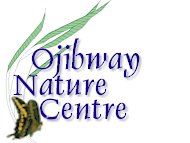
LINKS
Main Menu
Site Map & Links
Bats of Essex County
Bat Photo Gallery
Ontario Rabies information
Mammals of Ojibway

ORDER MARSUPIALIA
Common Opossum - Widespread. The Ontario population has increased dramatically in recent years. It was very rare in Essex County until 1990 but very quickly became widespread and common. Opossums are active year round.
ORDER INSECTIVORA
Short-tailed Shrew
ORDER CHIROPTERA
Little Brown Bat - Rare. (one fall record).Silver-haired Bat - Rare. (records for June and February).
Big-brown Bat - Common. The most common species in urban areas and the most likely species to use a bat box. This is the only bat which commonly overwinters in Windsor.
Red Bat - Fairly common summer resident of woodlands. This bat can often be seen flying around the Nature Centre at dusk.
Hoary Bat - Uncommon summer resident of woodlands.
(Click here for more information on bats in Essex County.)
ORDER PRIMATES
People - Common and widespread.
ORDER LAGOMORPHA
European Hare - Uncommon in open agricultural fields near the Detroit River. This species was introduced to Ontario in 1912.Eastern Cottontail - Common and widespread.
ORDER RODENTIA
Eastern Gray SquirrelGroundhog - Common. Thirty years ago the "woodchuck" was considered a rare mammal at Ojibway. Now they are widespread in the area and often seen around the nature centre.
Eastern Chipmunk - Common. Ojibway is the only area in Essex County that supports a population of these small ground squirrels.
White-footed Mouse - This is the common mouse of our woodland and prairie habitats.
Meadow Vole - Common in open grassy areas. Up to 450 per hectare have been recorded at Ojibway prairie during peak population cycles. In poor years populations decline to 15 per hectare.
Norway Rat - Uncommon, introduced.
House Mouse - Common, introduced. Seldom found far from buildings.
Meadow Jumping Mouse - Uncommon. This long-tailed mouse hibernates from September to May.
Muskrat - Common in ponds, ditches and marshy areas.
Beaver - two beavers were present along the Grand Maris drain near Howard Ave. in 2007 and 2008. Although not in the Ojibway area, beavers could be present here along the drain or Turkey Creek.

ORDER CARNIVORA
Coyote - Common. Numbers have increased in recent decades. More often heard than seen. For more information on Coyotes in the region please see Coyote Biology (PDF doc) and Coyote Fact Sheet (PDF doc).Red Fox - Common.
Gray Fox - Rare. There are a few records from the Ojibway area in the 1980's and 1990's.
Raccoon - Very Common and widespread. Raccoons are often seen raiding the contents of park gargabe cans at dusk.
Long-tailed Weasel - Uncommon.
Mink - Uncommon. Most often found near water.
Striped Skunk - Common and widespread.
